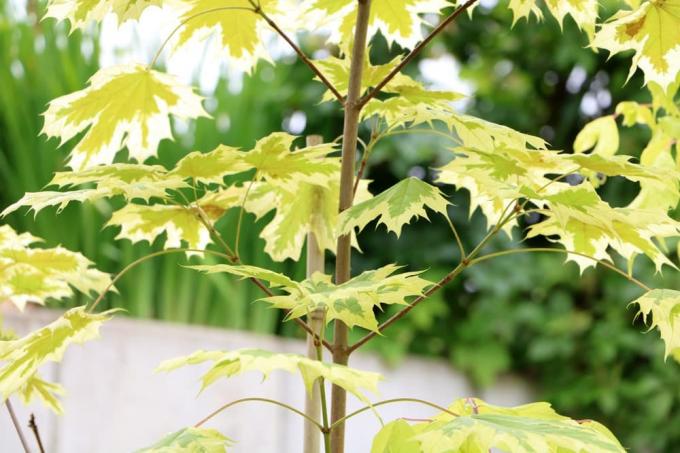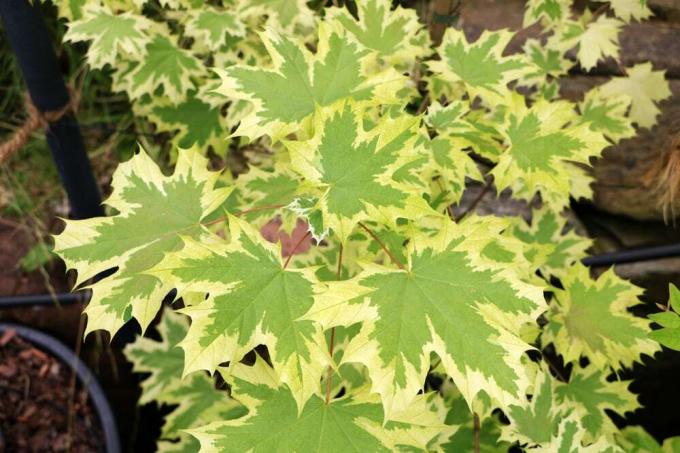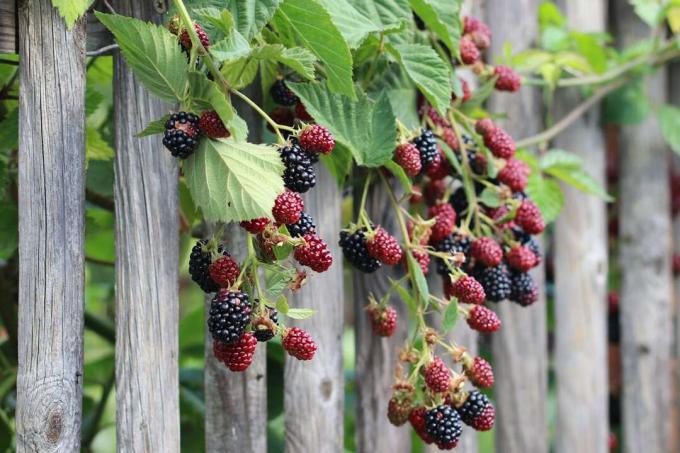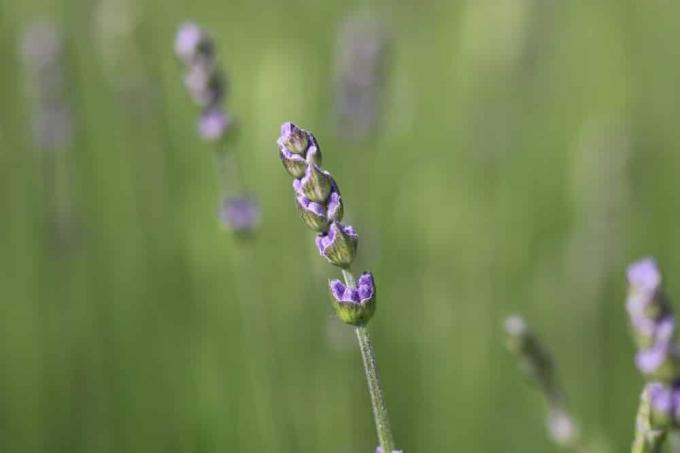

Table of contents
- When is the best time?
- Why is a regular pruning advisable?
- Cutting instructions Shape and maintenance cut
- Correction instructions
- Cutting instructions taper cut
- Tricky choice of date
- Cut above grafting point
- Disturbing shoots on the trunk of the maple tree - what to do?
- Breaking is better than cutting
- Cut off older wild shoots
- The right tool
The entire genus of maple trees is sensitive to pruning. In this regard, the maple tree is no exception. The reason is the strong sap flow during frost. If the tree loses a large part of its sap, it loses a great deal of resistance to diseases and pests. Therefore, choose a time for the pruning when the branches bleed little or not at all. Experience has shown that there is little or no sap flow on cuts when leafy.
When is the best time?
Late summer and fall have emerged as the best time to prune a maple tree. At this time, the juice pressure is at its lowest level. You can find out exactly when the ideal date is with a test cut. Cut back two or three thin branches and watch the sap flow. If the tree bleeds heavily, delay pruning for a week and do the test again.
Why is a regular pruning advisable?
We owe the decorative maple to a combination of skillful breeding and refinement. It is characteristic of an Acer platanoides 'Globosum' with a round crown that its terminal buds at the end of the branches sprout hardly more than the side buds. In contrast to the highly oval to pyramidal crowns of the wild species, the hybrid inspires with a spherical crown.

However, the spherical crown shape is only retained when young without horticultural intervention. An older tree tends to have ever-widening crowns, unflatteringly called a 'pancake crown'. In view of an annual growth of 20 to 40 cm, the undesirable development begins after just a few years. To counteract this striving, a spherical maple is subjected to a topiary every year.
So that the beautifully proportioned wood grows at the desired low height of 300 to 400 cm persevering, the crown in the nursery becomes the straight, slender trunk of a hardy wild species refined. Regular pruning is therefore not necessary to regulate height growth.
Cutting instructions Shape and maintenance cut
The dreaded sap flow after pruning is reduced to a minimum if you prune your maple back slightly every year. The extreme stress of a strong intervention is bypassed, so that your ornamental tree stays beautiful and healthy. If the shape and maintenance cut is based on these cutting instructions, you will enjoy your house tree for many years:
- Cut out dead branches from the crown in August/September
- Cut or saw deadwood on a branch without leaving stubs
- Remove or shorten branches pointing towards the inside of the crown
- All around, cut off all branches by a maximum of one third
- Set the scissors 3-5 mm away from a leaf or bud
Limit the pruning to the area of the branches that you can cut off with regular pruning shears. Experience has shown that a maple tolerates a cut in the thumb-thick branch area if it is done in good time before the first frost. The saw should only be used to clear out dead wood.
A notice:
Did you know that wound closure is no longer up-to-date in professional cut care? Modern research has revealed that sealing cuts with tree wax counteracts the healing process. Only after a winter cut should the edges of the wound be coated thinly with tree paste to protect the sensitive cambium wood from frost.
Correction instructions
– Pruning maple after storm damage –
If a violent storm has damaged the crown, simply thin out the maple tree first. Cut off the damaged branches without a stub just before the branch ring. It is important to note that you do not carry out the corrective pruning in frost, because the severe loss of sap will bring the already stressed tree to its knees. If numerous branches have to be removed, the crown will be too light and uneven. Since the remaining shoots are prone to break as a result, continue the measure according to the following cutting instructions:
- Shorten all branches all around so that the harmonious spherical shape is restored
- Ideally limit the cut to the thumb-thick branch area
- Cut off dead branches and branches pointing towards the inside of the crown
If you are forced to shorten thick branches, the tree will sprout strongly at this point. Remove the resulting excess branches in the following late summer by deriving a weaker shoot from the branches on the stronger one. Of course, it can take some time until the original spherical crown has completely formed again.
Tip:
Nowhere is it written that a maple can be pruned in a single day. In view of the risk of sap loss, it makes sense to spread a pruning measure over several dates in autumn. This prudence gives the maple time to regenerate its self-healing and defenses.
Cutting instructions taper cut

In an emergency, only a radical pruning can still prevent the clearing. Common causes are extreme storm damage, fungal diseases, pest infestation or aging. The following guide summarizes what to look for in a taper cut:
Tricky choice of date
When you can perform a rejuvenation pruning is not only determined by the season and the current sap flow. Radical pruning of all kinds also requires compliance with the Federal Nature Conservation Act. To protect breeding birds, extensive pruning measures are to be taken from 01.01. March to 30. Banned by law Sept. In order to meet the special requirements when pruning maple and at the same time act in accordance with the law, the time window is only open for a short time. Choose an appointment after the 30th. September and before the first frost, when the crown is ideally still in its foliage.
Cut above grafting point
Please do not use the scissors or saw in the middle of the trunk. Such an incision puts an end to all hopes of the automatic formation of a new spherical crown. Rather, only the wild base will sprout and develop into a conventional maple with a broadly oval or pyramidal crown. How to do it right:
- First thin out the damaged or aged crown thoroughly
- Cut dead wood, diseased, weak and too narrow branches down to the branch ring
- Cut back the remaining branches by up to two thirds
As long as at least one head with short shoots remains above the graft from the crown, a new spherical crown can develop from it. In the course of this development, pruning is limited to annual thinning out of too dense, weak and diseased branches. Once a satisfactory crown has formed, the autumn thinning is supplemented with a light topiary, as recommended in these instructions.
Disturbing shoots on the trunk of the maple tree - what to do?
If the spherical crown is enthroned on a particularly vigorous base, branches will sprout from the trunk and spoil the aesthetics. You may be confronted with this problem after a year or even decades. The master gardener speaks here of wild shoots or blind shoots, which have vital growth potential. Wild shoots compete with the noble variety for nutrients, water and access to light. Therefore, they strive to overgrow the crown above the grafting site. If this hustle and bustle is not stopped, your maple tree will be at a loss because it cannot win this fight on its own. Use the following strategy to fix the problem:
Breaking is better than cutting
If you have discovered a wild shoot in time, grasp the branch with your hand and break it off at the base. This procedure removes much more dividing tissue than scissors. After a cut, the wound heals better, so you'll be dealing with more wild shoots in a short amount of time than before. In addition, thicker and thicker ridges form as a result of the repeated overflowing of cambium wood after each cut.
Cut off older wild shoots
If you only notice a blind shoot after a year or more, breaking away will cause significant damage to the stem bark. In these circumstances, cut or saw off the unwanted branch. Smooth the cut with a knife and dust with charcoal ash. In the period that follows, please watch this trunk region with eagle eyes in order to break off young wild shoots in good time.
The right tool

The pronounced sensitivity to cutting of a maple requires special care when choosing the tools. Smooth, vertical cuts ensure sap can drain well and the tree recovers quickly. Meticulous cleanliness ensures that no pathogens make their way into the tree via contaminated blades. We therefore recommend scissors according to the bypass system. These work with two sharp blades, whereas anvil shears work with a sharp and a blunt side. The following tools and accessories are recommended for a smooth pruning:
- Secateurs for the central shape cut in the branch area with a maximum thumb thickness
- Two-hand pruning shears or folding saw for removing dead wood
- disinfectant or alcohol
- Cloth
- working gloves
- Stable ladder
Thoroughly clean blades and saw blades before and after trimming. If your pruning work involves multiple trees, please clean the tool when moving from one maple to the next.
 Home editorial office
Home editorial office
Learn more about pruning

Eucalyptus dried up: cut back now?
When a eucalyptus dries up, some owners immediately think of cutting it back. Because they want to see fresh green bud quickly. The chances of that happening may be good. But one thing must not be left out: research into the causes! Otherwise a new cycle of drying up and cutting begins.

Cut blackberries: Instructions for the right cut
Bramble branches only bear fruit for one summer, after which they are used up and die off in winter. It's a good thing that new canes grow back in time for the following year. Cutting care means: What no longer supports should be removed, young rods must be optimally trained.

cutting snowball | 13 tips for pruning
When it comes to snowballs (Viburnum), the opinions of numerous hobby gardeners differ when it comes to cutting. Main reason against pruning: Destruction of the natural appearance by pruning. Find out now when it is unavoidable and which tips should be heeded.

Cutting sage: 6 tips for cutting back
Cutting measures and their ideal time depend on the species of sage plants, because they have differentiated ways of life. There are woody and herbaceous representatives that require different attention. In order to carry out the measures, a basic set of tools is helpful.

Pruning hydrangeas: when is the right time?
Hydrangeas are a real beauty because of their flowers. In the long term, however, the flowering power is only maintained if regular pruning takes place. Because cutting off withered or dried plant parts offers protection. The following guide shows when this measure should be taken.

Cutting Lavender | When is the best time?
Lavender is a popular perennial, but difficult to cut. Without regular pruning, the shrub becomes lignified and less robust. Choosing the right time is important for pruning. When to cut depends on the use of the perennials.
